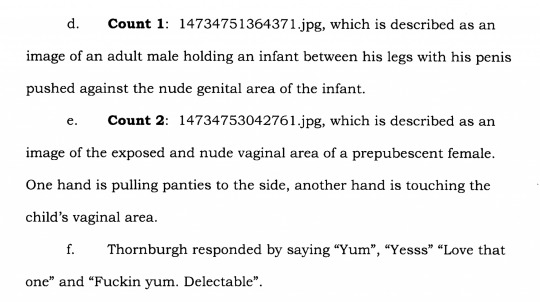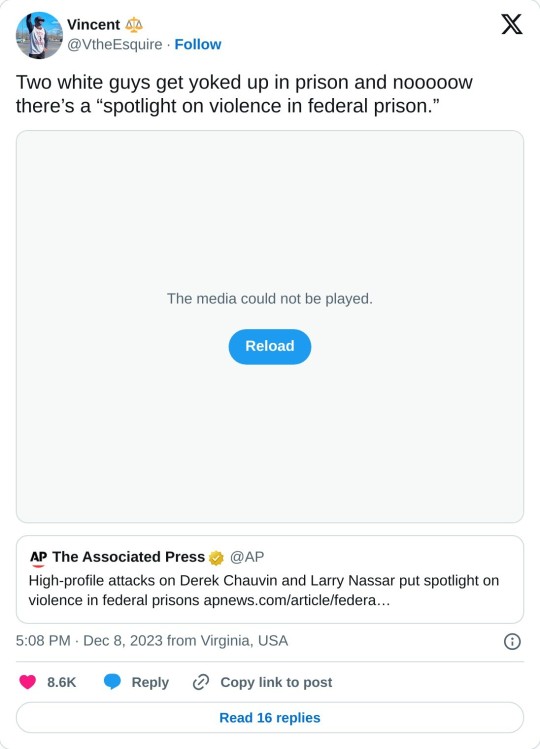#federal bureau of prisons
Text










#federal bureau of investigation#fbi corruption#fbi issues urgent warning for americans over fears of hamas copycats on us soil after horror terror attacks on israel#fbi surrounds penrose funeral home in fremont county#fbi cbs#fbi#federal bureau of prisons#federal bureau of control#nazisploitation#sacha baron cohen accuses tiktok of ‘biggest antisemitism movement since the nazis’#nazis#nazigate#nazi#all cops are bastards#all cops are bad#1312#acab1312#acab#fuck the police#ftp#right wing extremism#right wing terrorism#right wing politics#right wing women#right wing bullshit#far right#neofascism#cops#cop#police state
8 notes
·
View notes
Photo

"Giuseppe (Joe) Zangara who attempted to murder President-elect Roosevelt of the United States was today sentenced to eighty years in prison on four charges of attempts to murder. There are two further charges to be heard.”
- from the Kingston Whig-Standard. February 20, 1933. Page 2.
#miami#assassination attempt#political assassinations#sentenced to the penitentiary#life sentence#fdr#franklin delano roosevelt#joe zangara#history of crime and punishment#the great depression#federal bureau of prisons
1 note
·
View note
Text
0 notes
Link
0 notes
Text
Texas - where a woman with a life threatening pregnancy has to go before the state Supreme Court for a life saving abortion but this freak gets transferred because to a women's prison
By Anna Slatz December 12, 2023
A trans-identified male convicted of rape and child sexual abuse has been transferred to a women’s federal prison after launching a lawsuit against the Bureau of Prisons claiming “discrimination.” July Justine Shelby, born William McClain, was convicted on multiple counts of child pornography trafficking after being caught distributing photos of infants being sexually abused.
Shelby was initially arrested in November of 2016 in Indianapolis, Indiana, after being linked to a cellphone found to contain graphic images of child rape. Shelby had been sending the images to another man later identified as a romantic interest of Shelby’s named Beau Thornburgh.
Shelby had met Thornburgh while in prison, and the two had developed a relationship over the course of their 12 years incarcerated together.

When arrested, Shelby was on parole for rape and child molestation, and was not permitted to own a device which had access to the internet.
He was also subjected to GPS monitoring, which was quickly analyzed and used as additional evidence to connect him to Thornburgh, with Shelby appearing to regularly visit the other man’s residence. Thornburgh was also a registered sex offender at the time.
Shelby, who already identified as transgender at the time, was sentenced to 180 months in federal prison on charges of child pornography distribution and sent to Otisville FCI — a medium security institution for male offenders in New York.
He quickly began to present obstacles to his sentence, almost immediately filing a petition to have his conviction vacated after alleging his counsel had been “ineffective.” The court dismissed his motion, noting that he failed to demonstrate any evidence of the claim.
In 2020, Shelby filed a handwritten emergency writ of habeas corpus, claiming that his life was at risk in a men’s institution.

In the document, Shelby claimed multiple constitutional grievances, including that his First, Eighth, and Fourteenth Amendment rights were being violated on the basis of his gender identity.

Despite having been moved to a women’s prison, Shelby has continued to pursue legal action and demand various remedies. Among his new complaints are that he has been housed with the “worst of the worst” female offenders, and that his risk classification has been set too high.
In an April 2023 complaint, Shelby stated that the females on his unit have “made it clear” that he was not welcome at the facility, and that he lived in “fear” of being attacked by the “violent females” he was being housed with.
Shelby’s transfer appears to be the result of the Biden administration’s attempt to restore Obama-era guidelines surrounding the housing and treatment of transgender offenders in the federal system.
In January of 2022, the Bureau of Prisons re-issued its Transgender Offender Manual, which included guidelines previously scrubbed by the Trump administration with respect to gender self-identification for federal inmates. Under Trump, housing was based on biological sex alone, but the Biden policies re-invoked Obama-era guidelines which make a transgender inmate’s “personal safety” a priority.
The guidelines also stated that ‘misgendering’ is expressly forbidden, and that taxpayers must subsidize cosmetic surgeries, sex hormones, and brassieres for men who claim to identify as transgender.
According to Keep Prisons Single Sex USA, there are approximately 1,980 transgender offenders in the federal system, of which 1,295 are trans-identified males. Of them, almost 50% are in custody for sex offenses. This is compared to just 12% of the general federal inmate population, meaning that trans-identified males are incarcerated for sex offenses at a rate of almost four times that of non-transgender inmates.
Between 2022 and 2023, there was an almost 23% increase of federal inmates who identified as transgender.
#usa#Texas#Bureau of Prisons#Justine Shelby born William McClain#How the fuck was a guy in prison for rape and child molestation out on parole in the first place#KeepPrisonsSingleSex#1980 transgender offenders in the federal system of which 1295 are TIMs#almost 50% of TIMs are in custody for sex offenses#Betweem 2022 and 2023 there was an almost 23% increase of federal inmates who identified as transgender.
14 notes
·
View notes
Text
Tucker and Higgins: It was a TRAP
youtube
Thousands of Hours of New Footage: Uncovering Truth Behind Jan 6 | Facts Matter
#entrapment#defund the fbi#january 6#federal bureau of insurrection#political persecution#political prisoners#tucker carlson#banana republic#arrest Pelosi#arrest liz Cheney#clay higgins
13 notes
·
View notes
Text
youtube
FBI investigation needs to happen in Mississippi. 215 bodies that no family member knows of that died of natural causes, murder, possibly used for body parts. A violation of civil rights for every one of them.
4 notes
·
View notes
Text
if any of you will use the word gulag to mean a single labour camp i'm gonna scream
if you use it as a plural i'm gonna scream even louder
#it was the SYSTEM! A GOVERNMENT AGENCY!#would you call an average usamerican prison a federal bureau of prisons??? no?
3 notes
·
View notes
Text

True Uniform - Promotional Products: Balloons
Looking for high-quality promotional products that are both reliable and affordable? Look no further than True Uniform - the federal government's premier source for promotional items! Whether you're looking for custom t-shirts, hats, pens, or even balloons, True Uniform has everything you need to promote your brand and get your message out there.
#promotional products#promotional items#promo products#military programs#health education#awareness campaigns#corporate apparel#conference supplies#logo products#imprinted items#custom products#custom items#UNICOR#Federal Prison Industries#Bureau of Prisons#veterans affairs#awards and recognition
0 notes
Text
The man who went viral in a photo showing his feet propped up on Nancy Pelosi’s desk during the riot at the U.S. Capitol on Jan. 6 was denied a request to have the rest of the summer to “arrange for his affairs” before starting a four-and-a-half year prison sentence, Law&Crime reported.
The federal judge overseeing his case also denied Richard “Bigo” Barnett's request to be sent to a low-security camp to serve out his term.
“Defendant has had ample time since his conviction to prepare for his incarceration and presents no compelling reasons to justify additional delay,” U.S. District Judge Christopher R. Cooper wrote in a brief order.
“Defendant’s request for a recommendation for a (Bureau of Prisons) placement beyond 500 miles from his home in order to qualify him for a minimum-security facility is also DENIED. Determinations regarding security-level placements lie in the sound discretion of BOP based on its internal criteria. The Court generally plays no role in those determinations.”
2K notes
·
View notes
Text
“The coronavirus pandemic has ravaged many disadvantaged communities. Those include people who are incarcerated; more than 2,700 inmates have died. In no small part, this is a delayed but inevitable consequence of the punitive criminal justice policies of the 1980s and 1990s. That era’s mandatory long prison sentences have slowly transformed many U.S. prisons into what one legal scholar called “maximum security convalescent homes.” And just as nursing homes were ravaged by the pandemic, so were prisons.
As we find in our research, the United States can expect to see more — and costly — health consequences from this increasingly geriatric prison population.
How did we get here?
In the 1980s and 1990s, policymakers in both parties competed to be “tough on crime” by mandating long prison sentences and reducing or eliminating opportunities for parole. In Washington and in every state capital, politicians ramped up punishments that included “three strikes” laws — in which anyone convicted of three felonies could be sentenced to life in prison — and statutes that mandated sentences of life without the possibility of parole. Every state now has such a law. Political scientists Bryan Jones and Frank Baumgartner have described how political leaders can focus on a few aspects of a complicated public policy question, leading to one-sided policies that eventually need to be corrected. We found something similar here.
To justify throwing away the key for hundreds of thousands of incarcerated individuals, significant intellectual groundwork had to be laid. This involved two main steps.
First, the United States had to abandon the idea that prisons rehabilitate. In 1974, sociologist Robert Martinson facilitated this with his National Affairs article “What Works? Questions and Answers about Prison Reform.” The article later became informally known as “Nothing Works!” It concluded that rehabilitation programs are ineffective, something that became widely accepted as fact, although Martinson himself would go on to repudiate this view.
A second major step involved dehumanizing those to be permanently incarcerated. Politicians came to believe that a new generation of “irredeemable” children — called, at the time, “super-predators” — would never be productive adults. Those two beliefs — that a new kind of remorseless sociopath had no chance of redemption — combined to enable policies that put children in prison until their natural deaths, perhaps 60 years later.
Ignoring the obvious
When U.S. leaders focused on getting tough, they had to ignore some uncomfortable facts. The United States would end up with tens of thousands of septuagenarian prisoners; they would need expensive medical care; they would be vulnerable to violence or exploitation by younger prisoners; their costly continued incarceration would add very little to public safety, as they would be unlikely to reoffend after a certain age; and their large numbers behind walls would involve human rights concerns.
More than 200,000 people in U.S. prisons now serve sentences that they cannot outlive. Our research showed that people who commit crimes leading to long prison sentences tend to be about 26 years old when the crime occurs. Such a person might now be about 56, if the offense took place in 1991 at the tough-on-crime movement’s peak. Twenty years from now, if we see another pandemic, that individual will be 76, suggesting there will be a further wave of illness and death behind bars. The figure below shows the relative shares of youthful and elderly people in U.S. prisons.
Without parole, prisons become infirmaries
In our recently published research, we simulated a prison population with parole, then eliminated parole to see what would happen mathematically. If most individuals come into prison at a relatively young age, and become eligible for parole after serving, say, 20 years, then the prison system never develops a very large number of elderly prisoners. Even with low rates of parole, when an individual is eligible after 20 years, few serve 50 years.
But with no possibility of parole, the number serving extremely long terms, and therefore growing into their 70s and 80s behind bars, expands dramatically. Eliminating the possibility of parole means that what had been unlikely now becomes inevitable. Parole not only offers the incarcerated individual a chance to leave; it also lets the system discharge infirm and elderly individuals once they no longer threaten community safety.
North Carolina’s experience illustrates these trends
Like other states, North Carolina adopted life without parole policies in 1994, part of revisions designed to reduce some crimes’ punishments and increase others. As the figure below shows, the prison population had been expanding rapidly before these changes. Afterward, it declined for almost a decade as fewer individuals served time for relatively low-level offenses. But after about 10 years, the trend reversed. Total incarceration numbers increased dramatically, as happened nationally as well.
While many analysts have critiqued mass incarceration, few have noted the change in the ages of those incarcerated. As you can see, North Carolina’s prisons didn’t add more individuals under the age of 30. All the growth was in the older age groups. What happened wasn’t that more were going to prison. Rather, they were less likely to leave.
Policymakers did not just get tough on crime in the 1980s and 1990s. They ignored costly parts of the picture, leaving their children’s generation to solve the resulting problems. Among other things, these policies made the coronavirus pandemic much worse in prisons than it might otherwise have been. The pandemic has been catastrophic in the nation’s prisons. But if we see another such crisis 10 or 20 years from now, the impact will be much worse as middle-aged prisoners age into their golden years behind bars.”
- Analysis by Frank R. Baumgartner, Tamira Daniely, Kalley Huang, Patrice McGloin, Niharika Vattikonda, Kamryn Washington, Sydney Johnson, Allison Swagert, Alexander Love and Lyle May, “Thousands of prisoners have died of covid-19. Because of the ‘tough on crime’ era, there’s worse to come.” The Washington Post. August 26, 2021.
#american prison system#federal bureau of prisons#coronavirus pandemic#coronapolitics#covid19#life without parole#three strikes law#mass incarceration#failure of rehabilitation#prisons don't work#penal reform#crime and punishment
1 note
·
View note
Text
John Deere's repair fake-out

Last week, a seeming miracle came to pass: John Deere, the Big Ag monopolist that — along with Apple — has led the Axis of Evil that killed, delayed and sabotaged dozens of Right to Repair laws, sued for peace, announcing a Memorandum of Understanding with the American Farm Bureau Federation to make it easier for farmers to fix their own tractors:
https://www.fb.org/files/AFBF_John_Deere_MOU.pdf
This is a move that’s both badly needed and long overdue. Deere abuses copyright law to force farmers to pay for official repairs — even when the farmer does the repair. That’s possible thanks to a practice called VIN locking, in which engine parts come with DRM that prevents the tractor from recognizing them until they pay hundreds of dollars for a John Deere technician to come to their farm and type an unlock code into the tractor’s console:
https://doctorow.medium.com/about-those-kill-switched-ukrainian-tractors-bc93f471b9c8
Like all DRM, VIN locks are covered by Section 1201 of the Digital Millennium Copyright Act (DMCA), a 1998 law that criminalizes distributing tools to bypass “access controls,” even if you do so for a lawful purpose (say, to fix your own tractor using a part you paid for). Violations of DMCA 1201 carry a penalty of 5 years in prison and a $500k fine — for a first offense.
This means that Deere owners are locked into using Deere for repairs, which also means that if Deere decides something isn’t broken, a farmer can’t get it fixed. This is very bad news indeed, because John Deere tractors are just computers in a fancy, mobile case, and John Deere is incredibly bad at digital security:
https://pluralistic.net/2021/04/23/reputation-laundry/#deere-john
That’s scary stuff, because John Deere is a monopolist, and a successful attack on the always-connected, networked tractors and other equipment it supplies to the world’s farmers could endanger the global food supply.
Deere doesn’t want to make insecure tractors, but it also doesn’t want to be embarrassed by security researchers who point out that its security is defective. Because security researchers have to bypass Deere tractors’ locks to probe their security, Deere can leverage DMCA1201 into a veto over who gets to warn the public about the mistakes it made.
It’s not just security researchers that Deere gets to gag: the company uses its repair monopoly to threaten farmers who complain about its business practices, holding their million-dollar farm equipment hostage to their silence:
https://pluralistic.net/2022/05/31/dealers-choice/#be-a-shame-if-something-were-to-happen-to-it
This all adds up to what Jay Freeman calls “felony contempt of business model,” an abuse of copyright law that allows a monopolistic corporation to reach beyond its own walls and impose its will on it customers, critics and competitors:
https://locusmag.com/2020/09/cory-doctorow-ip/
If Deere was finally suing for peace in the Repair Wars, well, that was wonderful news indeed — as I said, a seeming miracle.
But — like all miracles — it was too good to be true.
The MOU that Deere and the Farm Bureau signed is full of poison pills, gotchas, fine-print and mendacity, as Lauren Goode documents in her Wired article, “Right-to-Repair Advocates Question John Deere’s New Promises”:
https://www.wired.com/story/right-to-repair-advocates-question-john-deeres-new-promises/
For starters, the MOU makes the Farm Bureau promise to end its advocacy for state Right to Repair bills, which would create a repair system governed by democratically accountable laws, not corporate fiat. Clearly, Deere has seen the writing on the wall, after the passage in 2002 of Right to Repair laws in New York and Colorado:
https://www.eff.org/deeplinks/2022/06/when-drm-comes-your-wheelchair
These two bills broke the corporate anti-repair coalition’s winning streak, which saw dozens of state R2R bills defeated:
https://pluralistic.net/2021/05/26/nixing-the-fix/#r2r
Deere’s deal-with-the-devil is a cynical ploy to brake R2R’s momentum and ensure that any repairs are carried out on Deere’s terms. Now, about those terms…
Deere’s deal offers independent repair shops access to diagnostic tools and parts “on fair and reasonable terms,” a murky phrase that can mean whatever Deere decides it means. Crucially, the deal is silent on whether Deere will supply the tools needed to activate VIN locks, meaning that farmers will still be at Deere’s mercy when they effect their own repairs.
What’s more, the deal itself isn’t legally binding, and Deere can cancel it at any time. Once you dig past the headline, the Deere’s Damascene conversion to repair advocacy starts to look awfully superficial — and deceptive.
One person who wasn’t fooled is sick.codes, the hacker who has done the most important work on reverse-engineering Deere’s computer systems, culminating in last summer’s live, on-stage hack of a John Deere tractor at Defcon:
https://pluralistic.net/2022/08/15/deere-in-headlights/#doh-a-deere
Shortly after the announcement, Sick.codes tweeted how the fine-print in the MOU would have prevented him from doing the work he’s already done (including “a direct stab at me lol”):
https://twitter.com/sickcodes/status/1612484935495057409
As with other instances of monopolistic, corporate copyfraud — like, say, the deceptive Open Gaming License — the John Deere capitulation is really a bid to take away your rights, dressed up as a gift of more rights:
https://mostlysignssomeportents.tumblr.com/post/706163316598407168/good-riddance-to-the-open-gaming-license
[Image ID: Hieronymus Bosch's painting, 'The Conjurer.' The Conjuror's shell-game table holds a small John Deere tractor that the audience of yokels gawps at. One yokel is wearing a John Deere hat. The conjurer is holding a wrench.]
1K notes
·
View notes
Text
0 notes
Text
" “In the year 2024….” read the headline of an editor’s message in a 1970 issue of The Presidio, a publication out of the Iowa State Penitentiary. Even for people in prison, whose primary currency is time itself, the date felt far-fetched. Something so distant, it was more the setting of a science fiction novel than of a real-life possibility. Al Ware, the paper’s incarcerated editor, had just experienced the solar eclipse of the century, though Iowa was outside the range of the total eclipse. He whimsically mused on whether he’d be around for the next one—if he meant alive or still in prison is up for interpretation.
People travel for hundreds and thousands of miles to view total eclipses and consistently have difficulty describing the experience fully with just words. But even a partial eclipse can be a stunning spectacle. For those in prison, whose lives are often drudgery punctuated by fleeting moments of fear, being able to experience something collectively with people beyond the walls is the type of reprieve that buoys the psyche for quite some time.
I sat in prison for the partial eclipse of 2017. A far cry from how Florida prisons handled a total eclipse in 1970, the Federal Bureau of Prisons decided a dusk-like darkening of the sky was a security threat that warranted a total lock-down. Never mind that for half the year the sun set at dinner time, and we were allowed to continue going about our business, jogging on the rec yard, grabbing a book from the library, and just generally moving about the compound. Perhaps some nefarious actors would use the few minutes of diminished daylight in the middle of the day to orchestrate a prison break, or perhaps the reverse, introduce contraband.
It felt like my life came to a screeching halt the moment I was arrested. No longer did I feel like I was living, an active verb, I was merely existing. If I vanished off the face of the Earth, not a single thing would change in the world, so minimal was my presence, so isolated was my life. Headlines flashed across the television screens, one of my only tethers to the outside world. Floods in Houston, fires in California, a mass shooting in Miami. It was as if these events were happening in some other world, one to which I only had the narrowest window...
...And with that, she led us outside. She didn’t ask where the colander had come from, and I did not tell. Its round holes somehow cast crescent shadows, illuminating the laws of physics. The sky darkened but nothing like dusk, a bizarre energy filling the air—or perhaps it was the abject fear that I was risking time in the hole to watch odd-shaped shadows dance on the ground, unable to even look at the eclipse directly.
For days to come, we tried to explain to our friends what it felt like, what those colander hole shadows looked like. It was simply too difficult to describe.
Whether Al Ware is still around to see this eclipse—he would be eighty-two—is unknown. What is known is that at least a few hundred people that experienced the total solar eclipse from prison in the United States in 1970 are still in prison. The next total solar eclipse that can be seen from the contiguous US won’t be until 2044—and unless that’s your release date, I’m sure it feels just as abstract as 2024 felt to the men at the Iowa State Penitentiary back in 1970."
- Watching an Eclipse from Prison, by Morgan Godvin
75 notes
·
View notes
Text
ok ok ok. if qcellbit did grow up on the island as a young kid and was eventually moved or sent away for some reason or another. what if the prison he and tazercraft were put in was made and controlled by the federation
HEAR ME OUT HEAR ME OUTTTTTT ok. let me put on my tinfoil hat for a second. we know that the federation has influence outside this one island (tubbo asking "are there other islands in the census bureau" and cucurucho saying "classified" which if there weren't he likely would have just said "no") so THEORETICALLY one of the islands that are part of it could be the one alcatraz was on
the prison on quesedilla island (not the big white "correctional facility" but the one pac e mike were put in when foolish arrested them) does have quite a bit of resemblance to the fuga impossivel prison, and YEAH maybe that could just be a meta homage to their videos but LISTEN OK LISTEN. I'M JUST SAYING. i wouldn't put it past the federation to have made multiple prisons with similar designs and ALSO. ALSO. there is a lot of white quartz used in the fuga impossivel prison-- in the walls of the cells, in the ceiling of the dining room (i think?), in the small hallway between areas of cells-- which yes i know was just a random design choice back then but METAWISE THEY COULD TAKE ADVANTAGE OF THAT AND SAY IT WAS MADE BY THE FEDERATION ARE YOU HEARING ME
so like. what if cellbit was an unruly child. the feds couldn't influence him like they could bagi (bc yes i am running with the siblings theory) so they wiped his memory and tossed him away. he ended up in war with bbh, committed some horrible terrible crimes, and suddenly ends up back under the federation's watchful eye when he's sent to their prison. he's even worse than he used to be, but they can't just let him go again, because now he's a danger. he doesn't know where he came from, but they do, and they can't let him out of their sight again.
somehow, the little fucker escapes. they search for him across their many islands to no avail. eventually, they decide to put him out of their minds as just another failed experiment. they have other more important things to take care of, you know?
imagine their surprise and delight when years later, a boat crashes into one of their islands, and their unruly failure is back, sane and well adjusted, along with two of the people who helped him escape.
#qsmp#THIS IS MY NEW HEADCANON AND I AM STICKING WITH IT. OK.#THIS IS CANON IN MY MIND#whiskeys word soup
117 notes
·
View notes
